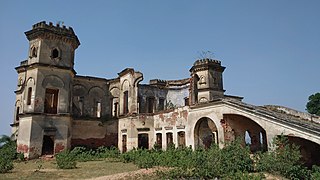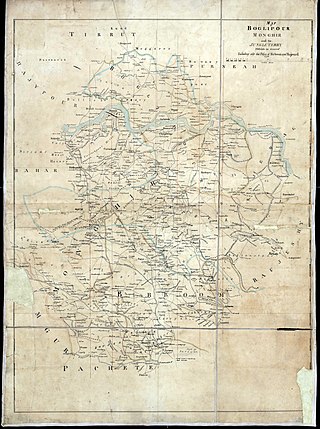Jamui is a town and a municipality in Jamui district in the Indian state of Bihar. It is the district headquarter of Jamui district. Jamui was formed as a district on 21 February 1991 as a result of its separation from Munger. It is part of Munger Division. The town is situated about 60km South-West of Munger.

Munger, formerly spelt as Monghyr, is a twin city and a Municipal Corporation situated in the Indian state of Bihar. It is the administrative headquarters of Munger district and Munger Division. Munger was one of the major cities in Eastern India and undivided Bengal during Mughal period and British Raj. It is one of the major political, cultural, educational and commercial center of Bihar and Eastern India. Munger is situated about 180km from east of capital city Patna, about 480km west of Eastern India's largest city Kolkata and 1200km from country's capital New Delhi.

Jamalpur is a city in the Indian state of Bihar. It is situated 9 km from the Munger city centre. Jamalpur is a part of Munger-Jamalpur twin cities.It is main railhead for reaching Munger city.

Jamui is a district among 38 districts of Bihar state, India. The district was formed on 21 February 1991, when it was separated from Munger district. It is located at a longitude of 86° 13'E and the latitude is 24° 55'N.

Munger district is one of the thirty-eight districts of Bihar state in eastern India. The city of Munger is the administrative headquarters of this district. The district is a part of Munger Division. Its literacy rate of 73.3% is higher than the state literacy rate of 63.8%, but lower than national rate of 74.04%.
Tarapur is a town and one of the three sub-divisions in Munger district in the Indian state of Bihar. It is centrally located and connects cities like Bhagalpur, Munger, Banka, Jamui and Deoghar.

Gidhaur is a small town in the Jamui District of Bihar. In the early-modern period, it was the centre of the Gidhaur chieftaincy.
Bhimbandh Wildlife Sanctuary is a wildlife sanctuary in Bihar in the south-west of Munger District.

The Munger Fort, located at Munger, in the state of Bihar, India, is built on a rocky hillock on the south bank of the Ganges River. Its history is not completely dated but it is believed that it was built during the early rule of Slave dynasty of India. The Munger town where the fort is situated was under the control of Muhammad bin Tughluq of Delhi. The fort has two prominent hills called the Karnachaura or Karanchaura, and the other a built up rectangular mound deduced to be the location of a citadel of the fort with historical links. The fort had a succession of Muslim rulers (Khaljis, Tughlaqs, Lodis, Nawabs of Bengal, followed by Mughal rulers, till it was finally acceded to the British by Mir Quasim, after unseating his father-in-law Mīr Jafar on the grounds of old age, for a monetary reward negotiated by Vansittart. This deal involved payment by the East India Company's merchants of an ad valorem duty of 9 percent, against an Indian merchant's duty of 40%. The fort became a place of considerable importance to the British in Bengal till 1947.
Dharhara is a community development block in Munger District of Bihar, India.

Jamalpur Junction railway station, station code JMP, is the railway station serving the Munger–Jamalpur twin cities in the Munger district in the Indian State of Bihar.

Shri Krishna Setu NH 333B is a rail-cum-road bridge across the Ganges, at Munger in the Indian state of Bihar and named after first Chief Minister of Bihar Shri Krishna Singh. The bridge connects the Munger-Jamalpur twin cities in Munger District to various districts of North Bihar. Srikrishna Setu Munger Ganga Bridge is the third rail-cum-road bridge over Ganga in Bihar.
Sita Kund is a Hindu pilgrimage site that honours the birthplace of the goddess, Sita. The Punaura Dham Janki Mandir is a Hindu pilgrimage site in Sitamarhi district, Bihar, which has an ancient Hindu temple. It is situated 5 km west of Sitamarhi City and a popular visitor's attraction.
Kharagpur may also refer to:

Lohra Village Jamui district, state of Bihar in eastern India.

Munger University is a state university and was established on 18 March 2018 through bifurcation of Tilka Manjhi Bhagalpur University, Bhagalpur. The university started operating academically from the 2018–19 academic year.

Kharagpur Raj was a prominent chieftaincy, founded in the early 16th century in Bihar situated mainly in modern-day Munger district. They were notable for being one of the few chieftaincies in Bihar to convert to Islam and many of the rulers became firm allies of the Mughal authorities. At its peak, the Kharagpur Raj encompassed parts of the modern-day districts of Munger, Bhagalpur, Jamui, Lakhisarai, Godda and Deoghar. Due to its size, the Privy Council compared it with the Kingdom of Sardinia.

The Gidhaur Chieftaincy was a principality which controlled parts of South Bihar for much of the medieval period in India. The chieftaincy was named after the town of Gidhaur in Jamui district but its territory extended into the wider region.
Bariarpur is a small town in the Munger district of Bihar state. Bariar (बरियार) means strong, hence Bariarpur means 'a place of the strong'.
Tilkari is a village in the Tetiya Bamber Block of Haveli Kharagpur in the Munger district of Bihar, India.













